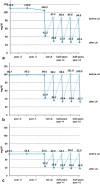Lipoprotein apheresis results in plaque stabilization and prevention of cardiovascular events: comments on the prospective Pro(a)LiFe study
- PMID: 25644612
- PMCID: PMC4361723
- DOI: 10.1007/s11789-015-0068-y
Lipoprotein apheresis results in plaque stabilization and prevention of cardiovascular events: comments on the prospective Pro(a)LiFe study
Abstract
Elevated lipoprotein(a) (Lp(a)) has emerged as an important independent cardiovascular risk factor, and causal association has been accepted with adverse outcome in atherosclerotic disease. Lipoprotein apheresis (LA) can lower low-density lipoprotein (LDL)-cholesterol and Lp(a) by 60-70 % and is the final escalating therapeutic option in patients with hyperlipoproteinemias (HLP) involving LDL or Lp(a) particles. Major therapeutic effect of LA is preventing cardiovascular events. Stabilizing plaque morphology might be an important underlying mechanism of action. In Germany, since 2008, a reimbursement guideline has been implemented to establish the indication for LA not only for familial or severe forms of hypercholesterolemia but also for Lp(a)-HLP associated with a progressive course of cardiovascular disease, that persists despite effective treatment of other concomitant cardiovascular risk factors, i.e. isolated Lp(a)-HLP. The Pro(a)LiFe-study confirmed with a prospective multicenter design that LA can effectively reduce Lp(a) plasma levels and prevent cardiovascular events.
Ein erhöhter Spiegel von Lipoprotein(a) (Lp(a)) ist ein bedeutender unabhängiger und kausal zu wertender kardiovaskulärer Risikofaktor. Die Lipoprotein-Apherese (LA) kann LDL-Cholesterin und Lp(a) um 60–70 % absenken und ist die ultima ratio der Therapie-Eskalation bei Hypercholesterinämie und Lp(a)-Hyperlipoproteinämie (Lp(a)-HLP). Der wesentliche therapeutische Effekt der LA besteht in der Prävention kardiovaskulärer Ereignisse. Die Stabilisierung der Plaquemorphologie könnte hierbei ein wichtiger Wirkmechanismus sein. Die deutschen Erstattungsrichtlinien für die LA umfassen seit 2008 nicht nur die familäre und schwere Hypercholesterinämie sondern auch die Lp(a)-HLP mit progredienter Gefäßerkrankung, die persistiert trotz effektiver Behandlung aller bestehenden kardiovaskulären Risikofaktoren und dann als isolierte Lp(a)-HLP bezeichnet wird. Die Pro(a)LiFe-Studie bestätigte mit prospektivem Multicenter-Design, daß die LA zur effektiven Reduktion der Lp(a)-Spiegel und Prävention kardiovaskulärer Ereignisse führte.
Figures


References
-
- German Federal Ministry of Health (2008) Publication of a decision of Federal Joint Committee on apheresis for isolated Lp(a)-elevation with progressive cardiovascular disease. Transactions Ger Fed Ministries (BAnz) 138:3321
Publication types
MeSH terms
Substances
LinkOut - more resources
Full Text Sources
Other Literature Sources
Medical
Miscellaneous

